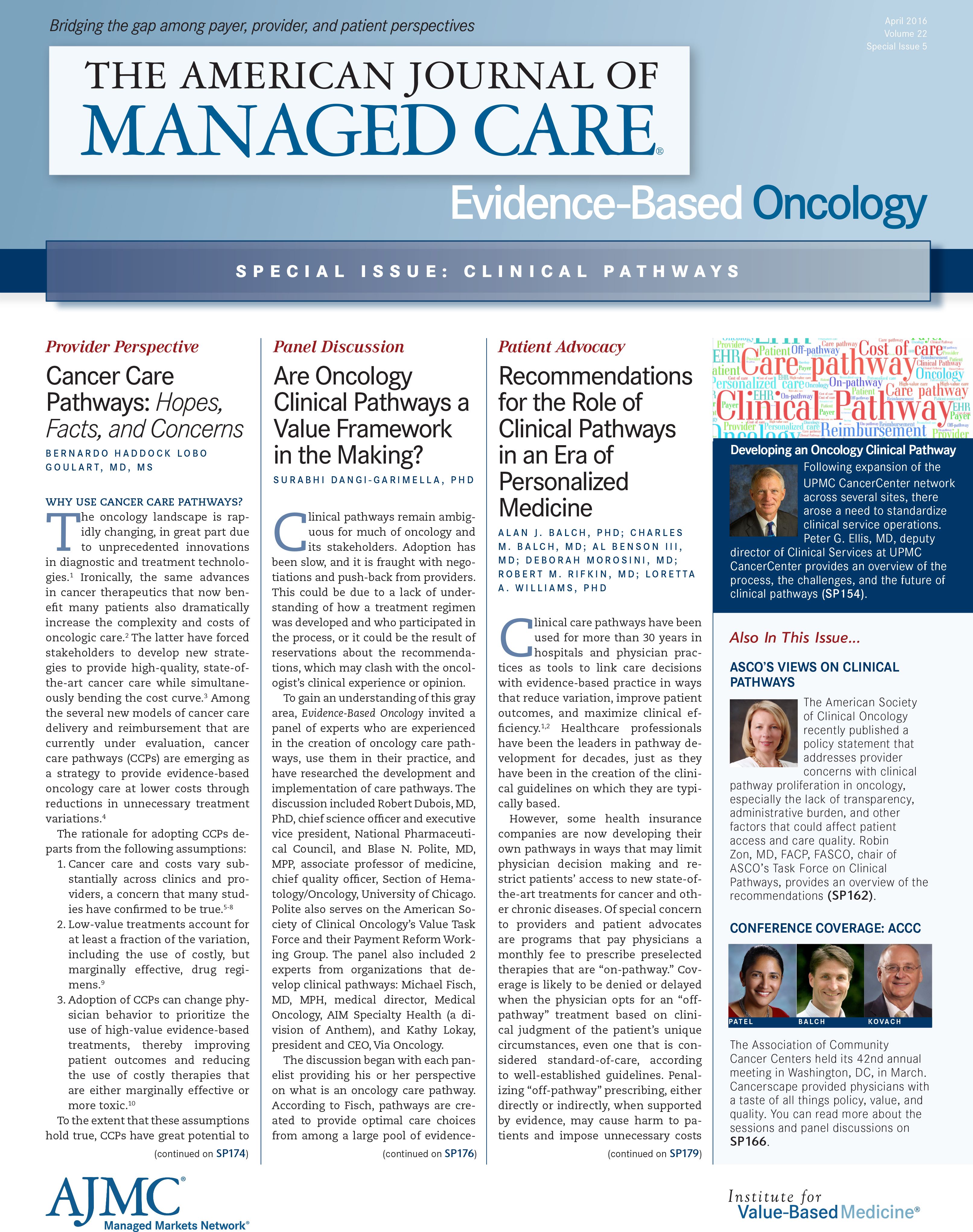Publication
Article
The Oncology Medical Home - Beyond Clinical Pathways
Author(s):
Clinical pathways have been emphasized as a means to deliver efficient, quality care and to ensure better outcomes at lower costs. The Oncology Medical Home takes this to the next, more comprehensive, step of quantifying and improving quality and value in cancer care while lowering overall costs.
Introduction
With the skyrocketing costs of oncology care, it is imperative that the cancer care community develop a strategy to control costs, while providing high-quality, comprehensive care to patients diagnosed with cancer. Clinical pathways have been emphasized as a means to deliver efficient, quality care and to ensure better outcomes at lower costs. The Oncology Medical Home (OMH) takes this to the next, more comprehensive, step of quantifying and improving quality and value in cancer care while lowering overall costs. Patients, providers, policy makers, payers, and employers all agree that we must work together to curb the rising costs of cancer care while maintaining and promoting higher quality. This focus should encompass all aspects of the cancer care journey for patients and their family.
The OMH accreditation model being implemented by the American College of Surgeons’ Commission on Cancer (CoC) was designed to help cancer care teams transition their focus, energy, and processes to ensure the delivery of quality and value in cancer care. The model is centered around 5 core areas including:
- Patient engagement
- Expanded access
- Evidence-based medicine
- Team-based care
- Quality improvement
Achieving OMH certification includes specific guidelines for these areas that cover well defined policies and efficient procedures, and emphasizes compliance with or results from applying the guidelines. Evidence is to be provided through reporting and trending of compliance with the required policies and procedures, and proof of improved quality and value, as demonstrated in the 18 OMH measures.1 These measures are the result of a collaboration among an 18-member team of insurance payers, cancer care providers, practice administrators, and patients or patient advocacy organizations.
The CoC has been associated with recognizing and promoting quality cancer care. Founded in 1922, the CoC has been instrumental in improving cancer care in hospital-based cancer programs. In addition, the CoC has developed and maintained the National Cancer Data Base, which stores information on approximately 70% of newly diagnosed cancer patients in the United States. The CoC improves care by setting mandatory standards for cancer programs and using the data submitted by cancer programs to compare their compliance with mandatory quality measures.
Likewise, the OMH model has been developed as a mechanism to hold oncology practices accountable for meeting the standards that ensure quality, comprehensive care, and decreased variation. This is achieved through constant monitoring and measuring of compliance with the accepted standards and quality metrics—measuring compliance, and comparing it against peers, helps raise the bar in quality and will set the foundation for payment or delivery system reform. Examples of compliance measures include:
- Policies and procedures to minimize unnecessary emergency department (ED) visits and inpatient hospitalizations
- Proof of effectiveness of these policies and procedures to avoid ED visits and hospitalizations
- Improving patient satisfaction: each practice must administer a patient satisfaction survey and monitor results. The goal is to ensure that care is truly patient-centered and meets the needs of patients and their families or caregivers.
It Takes a Team: Distinct Perspectives on Quality and Value
OMH accreditation standardizes measurement and assesses performance against a set of uniform standards and requirements that may improve quality, outcomes, efficacy, and efficiency. Of course, oncologic outcomes cannot simply be defined by survival rates—they include demonstrated compliance and improvement of evidenceâ€based standards, improvement in quality measures, patient and family engagement, and a variety of patientâ€centered services.
There are 3 central perspectives to be considered when measuring the quality and value of the OMH model: patients, providers, and payers.
All cancer patients expect a positive outcome following their treatment, along with an individualized survivorship care plan for the best quality of life. Patients also merit education on diagnosis, treatment, and financial implications, so that they may make informed care decisions, and have confidence that their input and preferences are taken seriously by their trusted clinicians.
Oncology clinicians are being asked to provide evidence and rationale for their clinical decisions with proof in the form of measurable quality and value. Under the OMH model, this includes adherence to proven treatment plans, appropriate and timely communication with patients and their families, minimizing unnecessary visits to hospital EDs, and survivorship care. In return, clinicians are seeking better reimbursement rates along with higher patient satisfaction of the care delivered.
For the payer, cost-efficient care is a priority. Insurance companies are urging hospitals and private clinics to help reduce the rising costs of cancer care by promoting and providing evidence-based care that minimizes unnecessary expenditures. Clinical pathways and performance measures are 2 strategies that can help achieve this. If all these interests are to be met successfully, it is vital that clinicians, patients, and payers continue to work together to define the measures of what high-quality, high-value oncology care is.
Accreditation of the Oncology Medical Home
An ideal cancer care team is focused on providing the right care at the right time, and, at the right place. At the core of the OMH are measures of quality, including patient satisfaction and value. These measures cover the full range of the cancer care journey, from diagnosis to the initial visit, through treatment and to survivorship or advanced care planning. They are intended to help improve clinical outcomes and increase cost efficiency of cancer care.
The OMH program covers all aspects of care delivery in a cancer clinic seeking accreditation. It is an oncology-specific version of the general patient-centered medical home model that takes into account the unique services and issues managed by cancer practices. Cancer clinics achieving accreditation are publicly recognized as, “Oncology Medical Homes.” According to standardized criteria, payers may find this accreditation helpful when evaluating whether payment reform initiatives are being implemented.
Implementing the Oncology Medical Home
This transition to evidence-based cancer care, in all aspects of the team model, begins with commitment. Each care team needs at least one champion who will educate, coach, and encourage the practice to take on this new accountability of their service. Historically, having a practice champion has proven to be the hardest step for any healthcare transformation.
For at least the last 50 years, healthcare has been structured to incentivize volume over value, with the system rewarding consumption or utilization. The concept of having healthcare services be evidence-based, validated, and recognized, in a quantifiable way, is relatively new. But it is an important step; so, having a champion rally the team may need to be repeated several times before a plan can truly be successfully implemented.
Those involved in developing an OMH often hear of how overwhelming and expensive the journey could be. The goal of the CoC-OMH team and allied supporters, who have helped lay the foundation for today, is to minimize the administrative and financial tasks that may be encountered. This sets the OMH program apart from other programs.
The OMH model does not prescribe how to accomplish a certain goal; instead, it simply emphasizes the goal that needs to be met. The cancer care team has the flexibility to determine the most efficient path towards achieving the goal and the target, and measurable outcomes will be proof that they are a leader among their peers.
For those considering the OMH, implementation of the patient survey is probably the easiest step to grease the wheels of change. Deployment is extremely easy and the feedback paints the picture of how specific areas might be benchmarked, discussed, and addressed. The bonus, for adopting the model, are patient surveys that reflect the patient’s view of how well a practice is performing with achieving high standards.
Conclusions
Healthcare has come a long way in the last 5 years, and it seems cancer care has been on the forefront of that change. What was a specialty emphasizing clinical pathways only is now pursing evidence in all aspects of the field—from comprehensive and timely communications with patients and their families, to efficient and effective care, to appropriate survivor and end-of-life care. Most importantly, evidence is central to the entire care delivery model.
EBO
The CoC accreditation program for OMH provides an organized and comprehensive plan to guide any cancer care team that is ready to distinguish itself as leader in this era of healthcare reform and accountability.
Author Information:
Daniel P. McKellar, MD, FACS, is chair, American College of Surgeons, Commission on Cancer and medical director of Oncology, Wayne Healthcare.
Charles Bane, MD, is chairman, OMH Steering Committee and medical oncologist, Dayton Physicians Network.
M. Asa Carter, MBA, CTR, is senior manager, Commission on Cancer.
Allison Knutson, CCRP, is manager of Accreditation and Standards, Commission on Cancer.
Vicki Chiappetta, RHIA, CTR, is accreditation technical specialist, Commission on Cancer.
Bo Gamble, is director of Strategic Practice Initiatives, Community Oncology Alliance.
Address for correspondence:
Bo Gamble
Director, Strategy Practice Iniatitatives
Community Oncology Alliance
1101 Pennsylvania Avenue, N.W.
Suite 700
Washington, DC 20004
Reference
E-mail: bgamble@COAcancer.org
- 18 oncology medical home measures. Oncology Medical Home website. http://www.medicalhomeoncology.org/UserFiles/OMHMeasures111015v2.pdf. Updated November 10, 2015. Accessed March 2, 2016.


Review Emphasizes Potential Infection Risks With BTK Inhibitors




